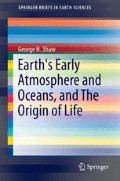Abstract
Geologic evidence for liquid oceans on the Earth nearly 4.5 billion years ago and astrophysical evidence for an early Sun 25% less luminous than present constitute the “Faint Young Sun” paradox. It appears that the most likely solution to this problem is higher levels of greenhouse gases in the atmosphere. However, the concentration of carbon dioxide required throughout the Hadean and Archean conflict with geologic data and would have been difficult to maintain given the reactivity of CO2 with silicates. Reduced gases have been suggested, but largely rejected because of their photochemical instability or because of implied production of an “antigreenhouse” haze. Hydrothermal production of ammonia and methane from an organic compound rich ocean (and submarine organic sediments) can solve the faint young sun problem.
Access this chapter
Tax calculation will be finalised at checkout
Purchases are for personal use only
References
Cruse AM, Seewald JS (2006) Geochemistry of low molecular weight hydrocarbons in hydrothermal fluids from middle valley, northern Juan de Fuca Ridge. Geochim Cosmochim Acta 70:2073–2092
Haqq-Misra JD, Domagal-Goldman SD, Kasting PJ, Kasting JF (2008) A revised, hazy methane greenhouse for the Archean Earth Astrobiology 8:1127–1137
Henderson-Sellers A (1979) Clouds and the long-term stability of the Earth's atmosphere and climate. Nature 279:786
Kasting JF (1982) Stability of ammonia in the primitive terrestrial atmosphere. J Geophys Res 87:3091–3098
Kasting JF (1993) Earth’s early atmosphere. Science 259:920–926
Kasting JF (1997) Warming early Earth and Mars. Science 276:1213
Kasting JF (2004) When methane made climate. Sci Am 291:78–85
Kasting JF (2005) Methane and climate during the precambrian era. Precambrian Res 137:119–129
Kuhn WR, Atreya SK (1979) Ammonia photolysis and the greenhouse effect in the primordial atmosphere of Earth. Icarus 37:207–213
Nutman AP (2006) Antiquity of the oceans and continents. Elements 2:223–227
Pavlov AA, Kasting JF, Brown LL, Rages KA, Freedman R (2000) Greenhouse warming by CH4 in the atmosphere of early Earth. J Geophys Res 105:11981–11990
Pavlov AA, Brown LL, Kasting JF (2001) Shielding of NH3 and O2 by organic hazes in the Archean atmosphere. J Geophys Res 106(E10):23267–23287
Rossow WB, Henderson-Sellers A, Weinreich SK (1982) Cloud feedback: A stabilizing effect for the early Earth? Science 217:1245
Rubey WW (1951) Geologic history of sea water: an attempt to state the problem. Geol Soc Am Bull 62:1111–1147
Rubey WW (1955) Development of the hydrosphere and atmosphere, with special reference to probable composition of the early atmosphere. In: Poldervaart A (ed) Crust of the Earth, Vol. 62. Geological Society of America Special Paper, Denver, pp. 631–664
Sagan C, Mullen G (1972) Earth and Mars: evolution of atmospheres and surface temperatures. Science 177:52–56
Schaefer L, B. Fegley J (2007) Outgassing of ordinary chondritic material and some of its implications for the chemistry of asteroids, planets and satellites. Icarus 186:462–483
Schaefer L, Fegley B Jr (2010) Volatile element chemistry during metamorphism of ordinary chondritic material. Icarus 205:483–496
Seewald JS (2001) Aqueous geochemistry of low molecular weight hydrocarbons at elevated temperatures and pressures: constraints from mineral buffered laboratory experiments. Geochim Cosmochim Acta 65:1641–1664
Seewald JS, Seyfried WE Jr., Thornton EC (1990) Organic-rich sediment alteration: an experimental and theoretical study at elevated temperatures and pressures. Appl Geochem 5:193–209
Seewald JS, Seyfried WE Jr., Shanks WC III (1994) Variations in the chemical and stable isotope composition of carbon and sulfur species during organic-rich sediment alteration: an experimental and theoretical study of hydrothermal activity at Guaymas basin, Gulf of California. Geochim Cosmochim Acta 58:5065–5082
Seewald JS, Zolotov MY, McCollom T (2006) Experimental investigation of single carbon compounds under hydrothermal conditions. Geochim Cosmochim Acta 70:446–460
Shaw GH (2008) Earth’s atmosphere: hadean to early proterozoic. Chem Erde 68:235–264
Wilde SA, Valley JW, Peck WH, Graham CM (2001) Evidence from detrital zircons for the existence of continental crust and oceans on the Earth 4.4 Gyr ago. Nature 409:175–178
Wolf ET, Toon OB (2010) Fractal organic hazes provided an ultraviolet shield for early Earth. Science 328:1266
Zahnle K, Schaefer L, Fegley B Jr (2010) Earth’s earliest atmospheres. In: Deamer D, Szostak JW (eds) The origins of life. Cold Spring Harbor Laboratory Press, Cold Spring Harbor, pp. 49–66
Author information
Authors and Affiliations
Corresponding author
Rights and permissions
Copyright information
© 2016 Springer International Publishing Switzerland
About this chapter
Cite this chapter
Shaw, G. (2016). The Faint Young Sun Problem. In: Earth's Early Atmosphere and Oceans, and The Origin of Life. SpringerBriefs in Earth Sciences. Springer, Cham. https://doi.org/10.1007/978-3-319-21972-1_10
Download citation
DOI: https://doi.org/10.1007/978-3-319-21972-1_10
Published:
Publisher Name: Springer, Cham
Print ISBN: 978-3-319-21971-4
Online ISBN: 978-3-319-21972-1
eBook Packages: Earth and Environmental ScienceEarth and Environmental Science (R0)

